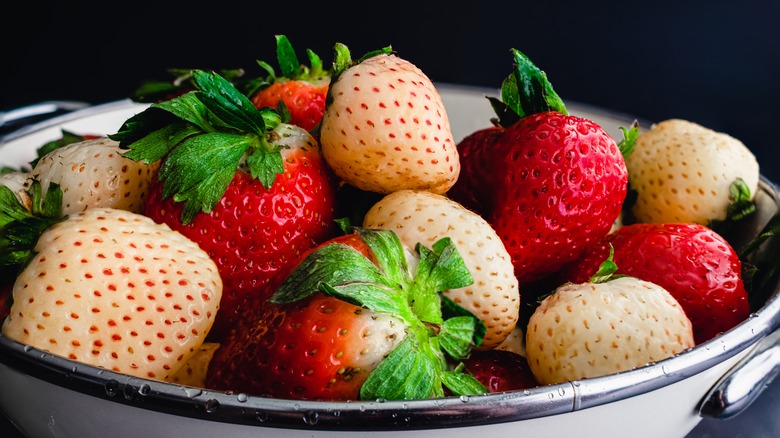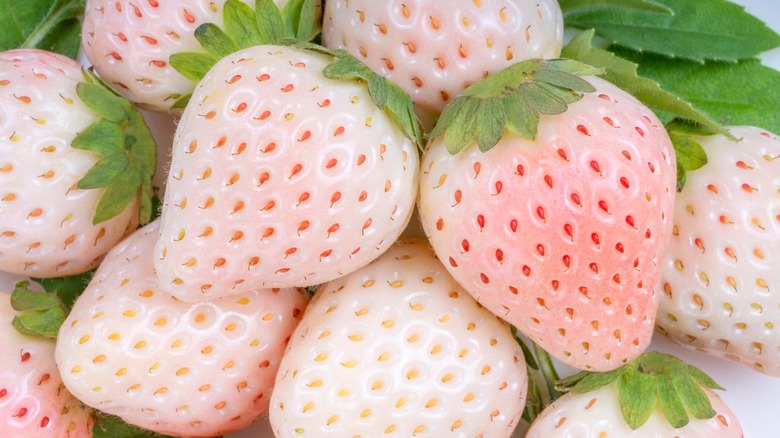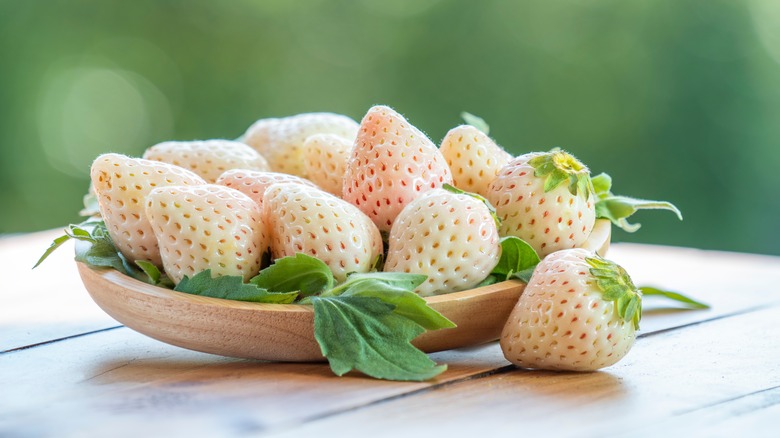The Tropical Flavor Difference Between Red And White Strawberries
When browsing through produce, you may come across white strawberries. While it is true that the fruit can take on a whitish-green hue prior to ripening, one of the things you may not know about strawberries is that the all-white ones are actually a different, fully ripe variety. The major distinction between these and the standard red — besides the obvious color shift — is a hint of a tropical palate they feature.
Depending on the variety, white strawberries can take on a few different flavors. In general, though, the lighter fruits taste extra sweet and a little tangy — like if a strawberry and a pineapple were blended together. Their intensity is a little more muted, which may be due to the increased water content in their flesh. This can make the strawberries feel a little juicier when bitten into.
Since the white fruit tastes quite similar to its ubiquitous red counterpart, it can be swapped into recipes as an even replacement — so long as you don't mind the tropical touch. They can make for a fresh flavor burst in Chantilly cake with berries, or brighten up your morning smoothie. Of course, you can also eat any white strawberry variety on its own to enjoy the subtle differences.
There are many varieties of white strawberries
There are quite a few different varieties of white strawberries, but many of them can be categorized into three types. Alpine strawberries, which may remind one of guava in addition to pineapple and strawberry, originally grew in Europe. They are smaller in size, and can appear tinged with yellow or green.
Beach or coastal strawberries, native to Chile, may exhibit additional flavor notes of grapes or caramel, but these pink-and-white berries grow only to small sizes. They have been crossbred with other strawberry varieties to produce larger fruits, but are not often sold on their own.
Pineberries, available in some specialty grocery stores, feature a pink tint to the outer skin if exposed to sunlight. They first appeared in South America before migrating to France. These berries are larger than other all-white varieties. If you purchase a package of them, be sure to clean the strawberries properly to enjoy their full flavor range. Pineberries both taste and smell slightly like pineapple, and have a super soft texture.
One type is especially sought after in Japan
One especially luxurious variety is the White Jewel, grown in Japan. It has a milder sweetness, and a rosy aroma. Farmer Yasuhito Teshima crossbred different strawberries, and restricted sunlight during the growing period to reduce the development of anthocyanins, which provide the signature red hue. In their absence, the fruit turns a bright white.
These restrictive growing regulations mean that the cultivar can be difficult to produce. Although farmers may end up with a full crop of strawberries, only around 10% of the harvest achieves that coveted bright white color. Any strawberries with a different hue, bruises, or scratches on the surface are turned into jams or syrups.
Some consider the White Jewel to be of superior quality due to the extra attention given during its growth, but this comes at a cost to consumers. Despite being in high demand and often given as gifts, a single White Jewel strawberry can cost around $10, and up to $150 for a pack of eight. Still, their continued popularity proves that they might just be worth it to savor the unique flavor.



